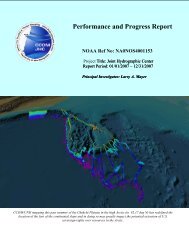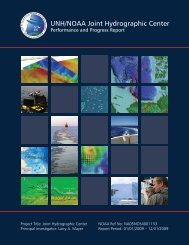Performance and Progress Report - John Doe FIX: put in the authors ...
Performance and Progress Report - John Doe FIX: put in the authors ...
Performance and Progress Report - John Doe FIX: put in the authors ...
You also want an ePaper? Increase the reach of your titles
YUMPU automatically turns print PDFs into web optimized ePapers that Google loves.
Sensitive Sea Areas (PSSAs) on electronic charts as m<strong>and</strong>ated by <strong>the</strong> International<br />
Maritime Organization (IMO).<br />
Revolutionary:<br />
With<strong>in</strong> <strong>the</strong> context of <strong>the</strong> “revolutionary” effort, Col<strong>in</strong> Ware, Kurt Schwehr, Matt<br />
Plumlee, Rol<strong>and</strong> Arsenault <strong>and</strong> Matt Qu<strong>in</strong>n have been extend<strong>in</strong>g <strong>the</strong> capabilities of<br />
GeoZui4D (as described above) as well as develop<strong>in</strong>g specific applications for <strong>the</strong> chart<br />
of <strong>the</strong> future. The GeoZui4D version that has become <strong>the</strong> base for <strong>the</strong> Chart of <strong>the</strong> Future<br />
project is now called GeoNav4D. Many of <strong>the</strong> new capabilities were described past<br />
reports (<strong>and</strong> <strong>in</strong> <strong>the</strong> description of <strong>the</strong> flow visualization above). With <strong>the</strong> arrival of Kurt<br />
Schwehr, <strong>the</strong> Chart of <strong>the</strong> Future project has undergone a re-evaluation <strong>in</strong> terms of <strong>the</strong><br />
immediate focus be<strong>in</strong>g taken. Dur<strong>in</strong>g <strong>the</strong> past few years, <strong>the</strong> Center has demonstrated a<br />
number of chart<strong>in</strong>g components that have ga<strong>in</strong>ed wide notice. For example, <strong>the</strong>se pieces<br />
<strong>in</strong>clude:<br />
• Path plann<strong>in</strong>g with time dynamic depth contours for safe, caution, <strong>and</strong> ground<strong>in</strong>g<br />
• Haptic perception of bathymetry<br />
• Pseudo-photo realistic render<strong>in</strong>gs with billboards <strong>and</strong> 360 disk panorama models<br />
• Basic ship position decod<strong>in</strong>g from AIS messages<br />
• Tide based flow model<strong>in</strong>g<br />
• Multi-ship <strong>and</strong> mar<strong>in</strong>e mammal coord<strong>in</strong>ated displays<br />
• Multiple view coord<strong>in</strong>ation<br />
• Analysis of a predictor for ship behavior to assist novice ship drivers<br />
The Center has met with NOAA, <strong>the</strong> USCG RDC, <strong>and</strong> <strong>the</strong> British Admiralty to start<br />
evaluat<strong>in</strong>g <strong>the</strong> components separately <strong>and</strong> <strong>in</strong> concert for possible test scenarios. As<br />
discussed <strong>in</strong> <strong>the</strong> previous year’s reports, <strong>the</strong> Center is work<strong>in</strong>g with NOAA on a<br />
showcase/demonstration project <strong>in</strong> <strong>the</strong> Port of Norfolk/Hampton Roads, VA. The target<br />
date is a presentation <strong>in</strong> conjunction with <strong>the</strong> US Hydro Conference <strong>in</strong> Norfolk <strong>in</strong> spr<strong>in</strong>g,<br />
2007. The Center will be deploy<strong>in</strong>g an AIS logg<strong>in</strong>g station to <strong>the</strong> area along with<br />
process<strong>in</strong>g <strong>and</strong> correlat<strong>in</strong>g <strong>the</strong> data products for <strong>the</strong> site. The goal is to show <strong>the</strong> best<br />
possible scenarios with today’s technology when all data types are present <strong>and</strong> <strong>in</strong>tegrated<br />
which currently not <strong>the</strong> case for any port area with<strong>in</strong> <strong>the</strong> cont<strong>in</strong>ental US.<br />
For <strong>the</strong> Chart of The Future project, Kurt Schwehr has embarked on an analysis of ship<br />
behavior <strong>and</strong> accidents. Initial work has established logg<strong>in</strong>g of <strong>the</strong> national Automatic<br />
Identification System (AIS) network created by <strong>the</strong> USCG Research <strong>and</strong> Development<br />
Center. This data can <strong>the</strong>n be correlated with <strong>in</strong>cidents <strong>and</strong> provide specific <strong>in</strong>stances of<br />
ship behavior. To complement this data stream, <strong>the</strong> Center is look<strong>in</strong>g at events listed <strong>in</strong><br />
reports compiled by <strong>the</strong> USCG MISLE Mar<strong>in</strong>e Casualty database. The Center has<br />
developed additional expertise with AIS by deploy<strong>in</strong>g an <strong>in</strong>itial AIS receive-only station<br />
<strong>in</strong> Portsmouth, NH for several months along with <strong>in</strong>stall<strong>in</strong>g a SOLAS class RM808 AIS<br />
unit provided by our <strong>in</strong>dustrial consortium partner L3/Kle<strong>in</strong>. In <strong>the</strong> future, <strong>the</strong> Center<br />
will deploy AIS stations as needed based on coverage holes <strong>in</strong> <strong>the</strong> USCG AIS network.<br />
JHC <strong>Performance</strong> <strong>Report</strong> 49 30 January 2007




